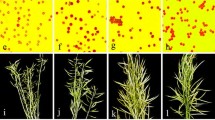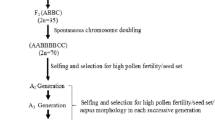Summary
Among the oleiferous Brassicas, B. napus has the highest seed and oil productivity. As it is a species adapted to the temperate regions, its spring type is either unable to flower or flowers too late in the short — day winter (rabi) season of the subtropics. B. napus (genome AACC) is an amphidiploid between B. campestris (AA) and B. oleracea (CC), and shares one genome with the other allotetraploids B. juncea (AABB) and B. carinata (BBCC). While B. napus lacks ecotypes adapted to the subtropics, the other four species are well represented in this climatic zone. Reciprocal crosses with or without one direct backcross to B. napus have been carried out with the intention of transfering short-day adaptability. The aim was to introgress the A genome of carefully selected early representatives of B. campestris and B. juncea with the corresponding genome in B. napus, and similary the C genome from B. oleracea and B. carinata with the analogous genome in B. napus. B. campestris, B. juncea and the clearly later species, B. oleracea var ‘alboglabra’ and B. carinata, seem to be almost equally effective in introgressing the appropriate earliness necessary for growth in Bangladesh. One backcross sligthly delayed segregation of early types. Convergent crosses did not result in the transgression of earliness, which was unexpected since the inheritance of flowering and maturity indicated a polygenic regulation. This result is partly explained by assuming dominant oligogenic control of the photoperiodic response. Introgression of earliness with the C genome doesn't seem to be necessarily related with the earliness of the donor species. Intergenomic interactions may be important. Interesting new lines were selected with high yield. Thus there is a good probability that Bangladesh will have a new oil crop. As these lines were observed to be early in Sweden as well, they could potentially push rapseed cultivation further north in temperate regions where the growing period is limited by short summers.
Similar content being viewed by others
References
Friend DJC, Helson VA (1966) B. campestris L. Floral induction by long day. Science 153:1115–1116
Kuriyama H, Wantanabe Y (1955) Studies on the haploid plant B. carinata. Jpn J Breed 5:1–15
MacKey J (1987) Implications of polyploidy breeding. Biol Zentralbl 106:257–266
Martinic Z (1973) Vernalization and photoperiodism of common wheat as related to general and specific adaptability of varieties. Plant response to climatic factors (Ecology and Conservation, 5). Proc Uppsala Symp UNESCO, pp 153–163
Martinic Z (1975) Photoperiodism, vernalization and adaptation in common wheat. Proc 2nd Int Wheat Conf, pp 197–205
Mizushima U (1950a) Karyogenetic studies of species and genus hybrids in the tribe Brassiceae of Cruciferae. Tohoku J Agric Res 1:1–14
Mizushima U (1950b) On several artificial allopolyploids obtained in the tribe Brassiceae of Cruciferae. Tohoku J Agric Res 1:15–27
Morinaga T, Fukushima E (1933) Karyological studies on a haploid mutant of Brassica napella. Cytologia 4:457–460
Olsson G (1960) Species crosses within the genus Brassica. I. Artificial Brassica juncea Coss. Hereditas 46:351–386
Olsson G, Hagberg A (1955) Investigation on haploid rape. Hereditas 41:227–237
Prakash S (1973) Non-homologous meiotic pairing in the A and B genomes of Brassica: its breeding significance in the production of variable amphidiploids. Genet Res 21:133–137
Ramanujam S, Srinivasachar D (1943) Cytogenetic investigations in the genus Brassica and the artificial synthesis of Brassica juncea. Indian J Genet Plant Breed 3:73–88
Richharia RH (1937a) Cytological investigation of Raphanus sativus, Brassica oleracea and their F1 and F2 hybrids. J Genet 34:19–44
Richharia RH (1937b) Cytological investigation of 10-chromosome species of Brassica and their F1 hybrids. J Genet 34:45–55
Röbbelen G (1960) Beitrag zur Analyse des Brassica-genomes. Chromosoma 11:205–228
Roy NN (1984) Interspecific transfer of Brassica juncea-type high blackleg resistance to Brassica napus. Euphytica 33:295–303
Shiga T (1970) Rape breeding by interspecific crossing between Brassica napus and B. campestris in Japan. JARQ 5:5–10
Stebbins GL (1950) Variation and evolution in plants. Columbia University Press, New York
Tsunoda S (1980) Echo-physiology of wild and cultivated forms of Brassica and allied genera. In: Brassica crops and wild allies. Jpn Sci Soc Press, Tokyo, pp 109–119
U N (1935) Genomic analysis in Brassica with special reference to the experimental formation of B. napus and peculiar mode of fertilization. Jpn J Bot 7:389–452
U N, Midusima U, Saito K (1937) On diploid and triploid Brassica raphanus hybrids. Cytologia 8:319–326
Author information
Authors and Affiliations
Additional information
Communicated by J. MacKey
This article forms part of the author's Ph.D. thesis
Rights and permissions
About this article
Cite this article
Zaman, M.W. Introgression in Brassica napus for adaptation to the growing conditions in Bangladesh. Theoret. Appl. Genetics 77, 721–728 (1989). https://doi.org/10.1007/BF00261250
Received:
Accepted:
Issue Date:
DOI: https://doi.org/10.1007/BF00261250




